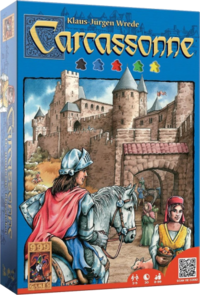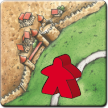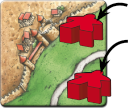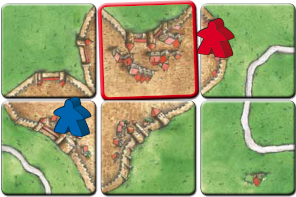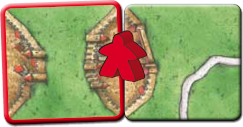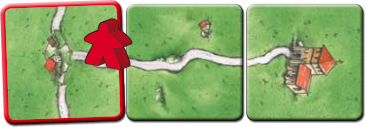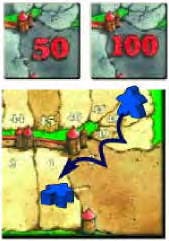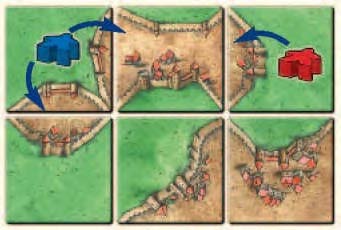Basisspel (1e editie)
Algemene informatie en commentaar
oorspronkelijk uitgegeven door Hans im Glück in Template:Year nl
Een slim tegel-leg spel voor 2 tot 5 spelers, voor de leeftijd van 8 en hoger door Klaus-Jürgen Wrede
De stad Carcassonne in Zuid-Frankrijk staat bekend om zijn unieke Romeinse en middeleeuwse vestingwerken. De spelers wagen hun kansen met hun volgers in de steden, kloosters, wegen en besneeuwde velden rond Carcassonne. De ontwikkeling van het land ligt in hun handen en de bekwame inzet van de horige als dieven, ridders, monniken en boeren is de weg naar succes.
Speelmateriaal
- 72 land tegels (inclusief een met een donkere achterkant) die weg-, stads- en veldsegmenten afbeelden, evenals kloosters en kruisingen.
- 40 followers in five colors[1]:
Followers in five colors
![]() Vraag: Too few followers—are we playing wrong or are there really too few?
Vraag: Too few followers—are we playing wrong or are there really too few?
Elke horige kan worden ingezet als ridder, monnik, dief of boer. Een horige van elke kleur wordt gebruikt op het scorebord om de punten van de speler mee aan te duiden.
- Een scorebord. Dit wordt gebruikt om de scores van de spelers bij te houden.
- Een spelregelboekje en een bijlage.
Regels
Overzicht
De spelers plaatsen de landtegels beurtelings. Dit leidt tot de groei van wegen, steden, kloosters en boerderijen, waar de spelers hun horigen op kunnen inzetten om punten te verdienen. Aangezien er zowel tijdens het spel als op het einde punten kunnen worden gewonnen, zal de winnaar alleen te voorschijn komen tijdens de eindscore.
Voorbereiding
The starting tile is placed in the middle of the table. The remaining tiles are mixed and placed face-down on the table in several stacks, so that each player can access them easily. Tiles can also be placed into a sack or game box and drawn randomly. The scoreboard should be placed at the edge of the table if possible.
Each player chooses a color and receives the eight followers, placing one on the ‘0’ field of the scoreboard as a scoring marker. The remaining seven followers stay with the player for the moment, as his or her supply.
The youngest player decides who starts the game.[2]
Spelverloop
Het spel gaat met de klok mee. De speler die aan de beurt is voert de volgende acties uit in de gegeven volgorde:
- The player must draw one new land tile and place it.
- The player may draw one follower from his or her supply and deploy it to the tile just placed.
- If any roads, cities, or cloisters are completed through the placement of the tile, they must be scored now.
Dan is de volgende speler aan de beurt.
1. Het plaatsen van een tegel
Als eerste actie, moet de speler moet een steen uit een van de stapels trekken. De tegel is wordt dan getoond aan de andere spelers (zodat zij mogelijk de speler kunnen 'adviseren' over waar hij het mag plaatsen) en op tafel gelegd. De speler moet de volgende punten in acht nemen:
Minstens één zijde van de nieuwe tegel (met een rood rand in de voorbeelden hieronder) moet een of meer tegels raken die al in het spel zijn. Hoek-tot-hoek plaatsing is niet toegestaan.
- Any city, road, and field segments must continue segments already in play. A newly placed land tile must fit the adjacent terrain on all edges. During placement it is not enough to look for only one side that fits.
In the rare case that a tile cannot legally be placed anywhere, and all players agree, it is removed from the game, and the player draws another.
2. Het plaatsen van een meeple
When the player has placed the tile, he or she may deploy a follower. In doing so the following points must be observed:
- Only one follower may be deployed each turn.
- The follower must come from the player's supply.
- The follower may only be deployed to the tile just placed.
- The player must decide which part of the tile the follower is deployed to as either:
- There must be no other follower (not even one belonging to the same player) on the road, city, or field segments connected to the tile just placed. It does not matter how far away the follower is. The following two examples may help to explain:
If a player runs out of followers during the course of play, he or she may only place tiles. But don't panic: you can also get followers back.
If you complete a previously unoccupied feature when placing a tile, you do not have to occupy it and earn the points. You can close the city or road without it being occupied and (for example) deploy a farmer as long as the farm is unoccupied. The city does not necessarily require a knight to look after it.
If any feature was completed through the placement of the tile, it must now be scored. If not, the player’s turn is over, and it is the turn of the next player on the left.
![]() Vraag: We have difficulty deciding when a placed tile represents a new city or belongs to one already being built.
Vraag: We have difficulty deciding when a placed tile represents a new city or belongs to one already being built.
![]() Vraag: On cloister tiles, are we allowed to deploy a follower on the surrounding field segment?
Vraag: On cloister tiles, are we allowed to deploy a follower on the surrounding field segment?
3. Het scoren van afgeronde wegen, steden en kloosters
Een voltooide weg
A road is completed when the road segments on both sides end in a crossing,[3] a city segment, or a cloister, or when the road forms a closed circle. There is no limit to the number of road segments which can lie between these endings.
A player who has a thief on this completed road scores as many points as the road is long, decided by counting the number of tiles.
Whenever points are scored, they are immediately recorded on the scoreboard (more on this in the section about the scoreboard).
![]() Vraag: Can a road end in nothing?
Vraag: Can a road end in nothing?
![]() Vraag: How are the road segments between T-junctions scored? Are the horizontal segments (on top of the T) also ends, or do these count as straight roads that have to be completed elsewhere?
Vraag: How are the road segments between T-junctions scored? Are the horizontal segments (on top of the T) also ends, or do these count as straight roads that have to be completed elsewhere?
Een voltooide stad
A city is completed when its segments are fully encompassed by a city wall and there are no gaps within the city.[4] There is no limit to how many segments a city may contain.
A player who has a knight in a completed city scores 2 points for every city segment. [5] Every pennant (banner / shield symbol) scores an extra 2 points. Note that a pennant only affects the city segment it is in, not the whole tile (if there is more than one segment on a single tile).
What happens if there are several followers on a completed road or in a completed city?
Through the wily placement of land tiles it is quite possible for several thieves to be on a road, or for several knights to occupy a city.
The points are then scored by the player with the most thieves or knights. In the case of a draw, all players involved score the full number of points.
Een voltooid klooster
A cloister is completed when it is surrounded by eight land tiles. The player who has a monk in the cloister immediately scores 9 points—1 point for every land tile.
Het terug geven van de meeples aan hun eigenaren
After a road, city, or cloister has been completed and scored – and only then – any thieves, knights, or monks involved are returned to their owner. From the next turn onwards, the player can then use them again in whatever role he or she chooses.
It is possible to deploy a follower, score immediately, and have the follower returned, all in the same turn. In this case, you must use the following order: [6]
- Complete a road, city or cloister with the new tile.
- Deploy a thief, knight or monk.
- Score the completed road, city or cloister.
- Return the thief, knight or monk to your supply.
![]() Vraag: If a player draws a tile with two city segments and completes a small city, earning 4 points, can he or she then deploy a follower to a new city segment in the same turn?
Vraag: If a player draws a tile with two city segments and completes a small city, earning 4 points, can he or she then deploy a follower to a new city segment in the same turn?
Weilanden
Several connected field segments form a farm. Farms and field segments are not scored. They serve only as places to deploy farmers; the owner of the farm only scores points at the end of the game. As such, farmers remain on the farm for the duration of the game and are never returned to their owner! [7] In order to make that clear, the farmers should be laid on their backs.
Farms are separated from each other by roads, cities and the edge of the playing field – this is important during the final scoring. In determining farm size, farms can be limited by all kinds of barriers, for example, roads, cities, or rivers which cannot be circumvented, or the edge of the playing field. It can certainly happen that a farm covers almost the entire playing field, and there will likely be farms that remain open for the entire game. [8]
Het scorebord
Any points scored should be recorded on the scoreboard immediately. The board is a track of fifty fields that can be lapped many times. When the field "0" is reached or passed the player takes a point tile (from Inns and Cathedrals) and places it in plain view of all other players, with the number "50" face up. In this way it is clear to all that the player has already scored 50 points or more [9] If the player reaches or passes the field "0" again, they should turn the point tile over so that the number "100" is face up. It is quite possible that the player might lap the circuit a third time: then he or she should take another point tile and display it next to the first, the "50" face up.[10]
Note: When two followers of one color are occupying a road, city, or farm, you DO NOT score double in these cases. The number of followers (or in Inns and Cathedrals the size of the followers) has no effect on the points that a player earns from a road, city, cloister, or farm. Two knights do not double the points. The number of followers is only important in establishing who has the majority.
Het einde van het spel
The game ends at the end of the turn in which the last land tile is placed.[11] Any roads, cities, and cloisters completed in this round are scored as usual. This is followed by the final scoring.
De eindtelling
Het scoren van niet afgeronde wegen, steden en kloosters
The first things to be scored during the final scoring are the incomplete roads, cities and cloisters. For every incomplete road, city and cloister the owner scores 1 point for every segment. Pennants also now score only 1 point. As soon as the feature in question has been scored, the followers involved are removed.
![]() Vraag: Final scoring: segments of incomplete roads. 1 point per follower or 1 point per road segment? Cloister: 1 point for every neighboring tile (e.g. 5), or is an incomplete cloister worth only 1 point?
Vraag: Final scoring: segments of incomplete roads. 1 point per follower or 1 point per road segment? Cloister: 1 point for every neighboring tile (e.g. 5), or is an incomplete cloister worth only 1 point?
Het scoren van de weilanden
Only the farmers and their farms are left, and these will be scored now. The owner of each farm should be established. If several players have farmers on a given farm, then the player with the most farmers is the owner. In the case of a draw, all the players with the most farmers are considered to be owners. The owner (or owners) of the farm score 3 points for every completed city which borders the farm, or lies within it. A bordering city is one that has a wall bordering the farm; a single point of contact at the corner of a tile is not sufficient. If a city borders more than one farm, the owner(s) of each farm score(s) 3 points for the city.[12] [13]
Every farm scores the bordering cities in the same way. When this has been done, the game is over.
The player with the most points wins.[14]
![]() Vraag: It is unclear whether incomplete farms earn points during the final scoring.
Vraag: It is unclear whether incomplete farms earn points during the final scoring.
![]() Vraag: At the end of the game, do we score farms which are completely closed off by roads, but which don't have any adjacent cities? If so, how?
Vraag: At the end of the game, do we score farms which are completely closed off by roads, but which don't have any adjacent cities? If so, how?
Voorbeeld van het scoren van een boer
Here is a more detailed example of how farmers and their farms are scored.
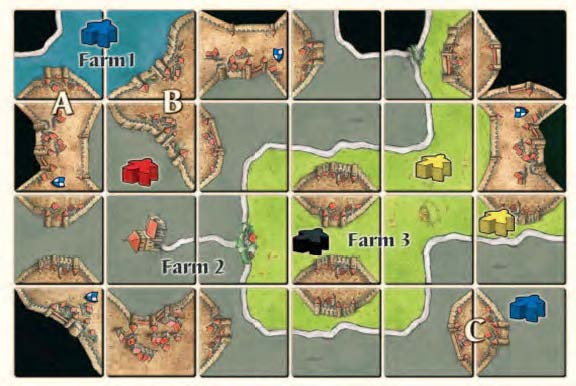
* Farm 1: BLUE owns farm 1. Two completed cities (A and B) border the farm. For each completed city BLUE scores 3 points (irrespective of their size), or a total of 6 points.
* Farm 2: RED and BLUE own farm 2. There are three completed cities (A, B and C) bordering or lying within this farm. RED and BLUE therefore score 9 points each.
Notice that cities A and B score points for BLUE on farm 1 as well as RED and BLUE on farm 2, since these cities border both farms. The city on the bottom left is incomplete, and so generates no points.
* Farm 3: YELLOW owns farm 3, since YELLOW has more farmers on it than BLACK. There are four completed cities bordering or lying within farm 3, so YELLOW scores 12 points.
Huisregels
- The players decide who starts the game by any method they choose—such as by rolling three followers. The first player to ‘roll’ a standing follower decides who plays first. (Thanks to Joff.)
- To determine the first player; each player draws a tile from the bag, the player that drew the tile with the most roads (0 to 4) plays first, if there is a tie for most roads, a draw-off takes place. This is repeated until someone wins. (Thanks to michael.)
- Take your next tile at the end of your turn, to give you time to think about placement and avoid analysis paralysis.
- Play with a three-tile hand. The abbey counts as part of your hand. Play your turn, including the builder, and then draw back up to three tiles. These tiles could be visible to all or hidden to the other players (Thanks to DavidP and youtch.)
- When playing with a bag for the tiles, the original starting tile may be put into the bag, and unplayable tiles can be put back into the bag rather than set to one side. (Thanks to dwhitworth.)
- Trees (bushes) on roads do not end the road—only houses do (when the road forks). This makes road building a lot more dynamic. (Thanks to Tobias.)
- When a tile is the only tile which can currently complete a structure, other players can offer to ‘buy’ it by offering points, trades counter, abbey, and so on. (Thanks to Deatheux.)
- If you place a tile that fills a hole in the playing field by touching something on all four adjacent sides, you get another turn. This helps motivate people to finish the board even if they do not get an advantage from the placement. (Does not apply to the abbey tile). (Thanks to viberunner.)
- Incomplete features at the end of the game do not score points at the end of the game. (Thanks to metoth.)
- The edge of the table limits the playing area. Thus, a player may not place a tile past the edge of the table or move the playing area to place a tile that would have been past the edge of the table. (Thanks to metoth for prompting this one, and to SkullOne for pointing out that this is an official rule from Hunters and Gatherers.)
- Table borders COMPLETE features as an abbey would. (Thanks to PreGy.)
- Use colored dice instead of meeples on the scoring track. Start out with the 6 showing on top. When the marker completes one lap, turn it to the number 1 to indicate it has completed one lap. This shows at a glance which player is on what lap and who's ahead. On the 100 space track it’s even easier to determine someone’s score at a glance. (Thanks to Carcking.)
Use of a Table
A number of questions have been asked about rules related to the play area itself, including what happens when the edge of the area is reached, or if a table has to be used for play. The following clarifications are from Georg Wild from HiG (5/2013):
- The edge of the table is the limit for the game if, as stated in the rules, a table is used.
- The rules state that the starting tile is placed in the middle of the table. If all of the tiles are shifted to allow more room, the starting tile would no longer be in the middle. So in principle, total shifting of the tiles is not allowed. Additionally, with a manual shift of all of the tiles, the tiles and figures on the field can slip, which could lead to incorrect positioning of tiles or figures.
- Addition of a second table is possible if one of an appropriate height is added to the first table. If a table is extended (as with an additional panel), make sure that the tiles and figures on the playing field do not slip.
- Playing on the floor: The rules technically do not allow this, because the rules state that the first tile is placed in the middle of the table. Playing on the floor is not forbidden, however, if use of a table is not feasible. If the floor is used, tiles must be placed so all tiles are visible to all players. Tiles cannot be placed under the sofa, cabinet/shelf, etc.
- It is important generally, that all the players in the round agree how to play:
- Table - Standard
- Table - with "total shifting" of tiles
- Table - with extension
- Floor
- Continue to play fairly and not intentionally unfair to other players.
Tegel distributie
Totale aantal tegels: 72[15]
Het onderstreepte getal bevat de starttegel.
Voetnoten
Ga voor licentie en uitleg over de pictogrammen naar de pictogrammen pagina.
- ↑
 This is not mentioned in the Big Box, Big Box 2, Big Box 3, Big Box 4 rules. The sixth player (gray) is listed here directly at the base game and not at Inns and Cathedrals. This makes the rules clearer. Additionally, Big Box 5 adds purple and pink followers for up to 8 players. Meeples in a additional colors can be acquired online.
This is not mentioned in the Big Box, Big Box 2, Big Box 3, Big Box 4 rules. The sixth player (gray) is listed here directly at the base game and not at Inns and Cathedrals. This makes the rules clearer. Additionally, Big Box 5 adds purple and pink followers for up to 8 players. Meeples in a additional colors can be acquired online.
- ↑
 This paragraph represents the current HiG rules. The RGG rules state that the players decide among themselves who will be the starting player, and the ZMG rules mention both options.
This paragraph represents the current HiG rules. The RGG rules state that the players decide among themselves who will be the starting player, and the ZMG rules mention both options.
- ↑
 In the game there are crossings and junctions. But since all crossings have the same effect—namely, to bring a road to an end—it was decided to sacrifice the distinction between crossings and junctions (or T-crossings, or T-roads...?) in order to not unnecessarily complicate matters.
In the game there are crossings and junctions. But since all crossings have the same effect—namely, to bring a road to an end—it was decided to sacrifice the distinction between crossings and junctions (or T-crossings, or T-roads...?) in order to not unnecessarily complicate matters.
- ↑
 The RGG edition states rather confusingly that “a city is complete when the city is completely surrounded by a city wall and there are no gaps in the wall.” Obviously, a city cannot be completely surrounded by a wall, and the wall have gaps at the same time. It is the city itself which cannot have gaps, as the HiG rules make clear.
The RGG edition states rather confusingly that “a city is complete when the city is completely surrounded by a city wall and there are no gaps in the wall.” Obviously, a city cannot be completely surrounded by a wall, and the wall have gaps at the same time. It is the city itself which cannot have gaps, as the HiG rules make clear.
- ↑
 Note that the so-called ‘small city’ rule is no longer used in any edition. This rule stated that a city of two segments—the smallest possible completed city— scored only 2 points, or 1 point per tile. Pennants in a small city also scored only 1 point each. However, small cities are now scored in the same way as every other city: that is, 2 points for every city segment, and 2 points per pennant.
Note that the so-called ‘small city’ rule is no longer used in any edition. This rule stated that a city of two segments—the smallest possible completed city— scored only 2 points, or 1 point per tile. Pennants in a small city also scored only 1 point each. However, small cities are now scored in the same way as every other city: that is, 2 points for every city segment, and 2 points per pennant.
- ↑
 Note in the box that features are considered to be complete as soon as the tile is placed, although follower placement and scoring only occur afterwards. This is important when playing with The Flier.
Note in the box that features are considered to be complete as soon as the tile is placed, although follower placement and scoring only occur afterwards. This is important when playing with The Flier.
- ↑
 Okay, “never” is a long time. In reality, some special mechanics in some expansions (Festival tiles, the Dragon, etc.) do allow return of farmers to their owners. (12/2014)
Okay, “never” is a long time. In reality, some special mechanics in some expansions (Festival tiles, the Dragon, etc.) do allow return of farmers to their owners. (12/2014)
- ↑
 River segments also separate farms. (08/2014)
River segments also separate farms. (08/2014)
- ↑
 The graphic here suggests that it might also be a good idea to lie the follower being used as a scoring marker flat on the scoreboard as the "50" is passed.
The graphic here suggests that it might also be a good idea to lie the follower being used as a scoring marker flat on the scoreboard as the "50" is passed.
- ↑
 This is the first real difference to previously published editions, now having its own section and a description of point tiles, which were previously considered to be a part of the Inns and Cathedrals expansion.
This is the first real difference to previously published editions, now having its own section and a description of point tiles, which were previously considered to be a part of the Inns and Cathedrals expansion.
- ↑
 Note that, according to the RGG 3Big Box 3 rules, the last land tile placed could be an Abbey tile. According to these most recent rules, “If one or more players have not yet placed their Abbey tiles when the last landscape tile is drawn and placed, they may now do so, if possible, in clockwise order starting from the left of the person who placed the last tile. Then, the game ends.” This is a reversal of a previous FAQ, which used the statement, “The game is over when the last face-down land tile has been played.” This older statement was to specifically prevent players from placing any abbey tiles which they may still have in their hand after the last ‘normal’ land tile (from the stack, the bag, or the dispenser) had been played.
Note that, according to the RGG 3Big Box 3 rules, the last land tile placed could be an Abbey tile. According to these most recent rules, “If one or more players have not yet placed their Abbey tiles when the last landscape tile is drawn and placed, they may now do so, if possible, in clockwise order starting from the left of the person who placed the last tile. Then, the game ends.” This is a reversal of a previous FAQ, which used the statement, “The game is over when the last face-down land tile has been played.” This older statement was to specifically prevent players from placing any abbey tiles which they may still have in their hand after the last ‘normal’ land tile (from the stack, the bag, or the dispenser) had been played.
- ↑
 This describes what is known as the "third edition" method of scoring farms, the method currently accepted by all publishers.
This describes what is known as the "third edition" method of scoring farms, the method currently accepted by all publishers.
- ↑
 Question: What are the differences to the rules of the first edition, when
Carcassonne won Game of the Year? Answer: The scoring of farms was not from the perspective of the farms themselves, as it is now, but rather from the perspective of the cities. For every city, you had to check how many farmers of each color were adjacent to it, irrespective of from which side. The player with the majority of adjacent farmers supplying a city would earn four points for it. Each city would as such only be scored once, and therefore earned more points. According to the old rules, BLUE would be the only one to score points, since two of his or her farmers are supplying the cities, even though they are on different farms. YELLOW has only one farmer adjacent to
the city and goes home without anything. According to the new rules, both farmers earn points; and following the most recent rule changes, BLUE even earns points twice.
Question: What are the differences to the rules of the first edition, when
Carcassonne won Game of the Year? Answer: The scoring of farms was not from the perspective of the farms themselves, as it is now, but rather from the perspective of the cities. For every city, you had to check how many farmers of each color were adjacent to it, irrespective of from which side. The player with the majority of adjacent farmers supplying a city would earn four points for it. Each city would as such only be scored once, and therefore earned more points. According to the old rules, BLUE would be the only one to score points, since two of his or her farmers are supplying the cities, even though they are on different farms. YELLOW has only one farmer adjacent to
the city and goes home without anything. According to the new rules, both farmers earn points; and following the most recent rule changes, BLUE even earns points twice.
- ↑
 The HiG rules do not have any instructions regarding what to do in case of a tie. The RGG rules state that tied players “rejoice in their shared victory.” The ZMG rules state, “In case of a tie, play another game to determine the winner!”
The HiG rules do not have any instructions regarding what to do in case of a tie. The RGG rules state that tied players “rejoice in their shared victory.” The ZMG rules state, “In case of a tie, play another game to determine the winner!”
- ↑
 Big Box 5 bevat eigenlijk deze 72 tegels met standaard achterkanten en één aparte starttegel. Er is dus in feite één extra tegel met een stadsdeel en een horizontale weg (CRFR, zie de tegel distributie) in de Big Box 5 basisset.
Big Box 5 bevat eigenlijk deze 72 tegels met standaard achterkanten en één aparte starttegel. Er is dus in feite één extra tegel met een stadsdeel en een horizontale weg (CRFR, zie de tegel distributie) in de Big Box 5 basisset.
